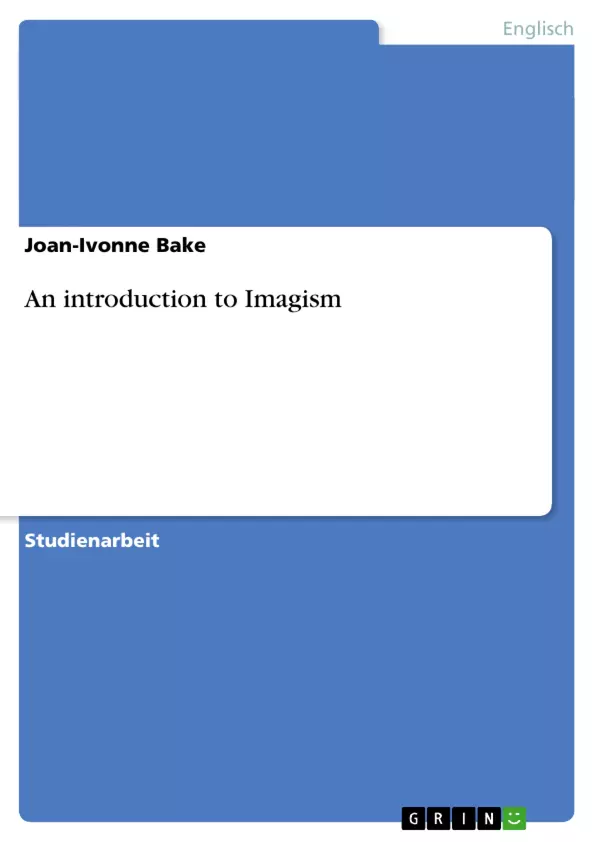I took a closer look at Imagism and its characteristic features and also at some of the most important Imagists, their ideals and main ideas of this literary epoch.
The first chapter deals with the origins of Imagism and describes where the Imagist got their creeds from and why they would have them. The second article is based on the master essay which was written together with Marie-Christin Miebach, Beate Steindor, Mira Rick and Beate Wrobel for the final reader of the seminar. It is picturing the characteristic features and the distinctive properties of the Imagist period. It deals with the question “What is Imagism?”, describing the goals of a movement in poetry that flourished in Britain and the United States in the 1920s.
The last chapter attends to a short interpretation of the Imagist poem “The great figure” (1920) by the American poet William Carlos Williams. In addition to this interpretation I will dwell on the interrelation of this poem and a picture by Charles Demuth which is called “I saw the Figure Five in Gold”. This one was painted in 1928 and is obviously a work which was inspired by the poem of Williams.
A conclusion in the end will summarize all the important facts and special features of Imagism.
Inhaltsverzeichnis
- Introduction
- The Origins of Imagism
- Imagism and Symbolism
- Other Influences
- What is Imagism
- Interpretation of “The Great Figure”
- Conclusion
Zielsetzung und Themenschwerpunkte
Diese Arbeit untersucht den Imagismus, eine literarische Bewegung der 1920er Jahre in Großbritannien und den Vereinigten Staaten. Das Hauptziel ist es, die Ursprünge des Imagismus, seine charakteristischen Merkmale und seine wichtigsten Vertreter zu beleuchten. Die Arbeit analysiert auch die Beziehung des Imagismus zu anderen literarischen Bewegungen, insbesondere zum Symbolismus.
- Die Ursprünge des Imagismus und seine literarischen Einflüsse
- Die charakteristischen Merkmale des Imagismus (z.B. Prägnanz, Bildhaftigkeit)
- Der Imagismus im Vergleich zum Symbolismus
- Interpretation eines repräsentativen Imagisten-Gedichts
- Die Bedeutung des Imagismus für die moderne Lyrik
Zusammenfassung der Kapitel
Introduction: Diese Einleitung beschreibt den Fokus der Arbeit: eine Auseinandersetzung mit dem Imagismus, seinen Merkmalen und wichtigen Vertretern im Kontext der "Roaring Twenties". Sie gibt einen Überblick über die Struktur der Arbeit, wobei die Kapitel zu den Ursprüngen des Imagismus, dessen Definition und einer Interpretation des Gedichts "The Great Figure" von William Carlos Williams angekündigt werden.
The origins of Imagism: Dieses Kapitel untersucht die historischen und literarischen Wurzeln des Imagismus. Es betont, dass der Imagismus, entgegen dem Anschein von Neuheit, auf antike (griechische, lateinische, hebräische, chinesische und japanische) und moderne (französische) Literatur zurückgreift. Die Arbeit hebt hervor, dass diese Einflüsse keine willkürliche Ansammlung waren, sondern eine harmonische Struktur bildeten, die sich in der Klarheit der Bilder, der Kürze und der Freiheit von metrischen Gesetzen manifestierte. Die verschiedenen Quellen und ihre individuellen Auswirkungen auf die Imagisten werden beleuchtet.
Imagism and Symbolism: Hier wird der Zusammenhang zwischen Imagismus und Symbolismus, insbesondere dem französischen Symbolismus, untersucht. Während der Symbolismus eine Affinität zur Musik aufwies, suchte der Imagismus eine Analogie zu den visuellen Künsten. Der Unterschied zwischen der abstrakten Sprache des Symbolismus und der prägnanten Bildsprache des Imagismus wird herausgestellt. Das Kapitel verdeutlicht, wie die Imagisten sich von der "wolkenhaften Sprache" des Symbolismus distanzierten und stattdessen auf konkrete Bilder und eine klare Sprache setzten, wobei sie überflüssige Wörter und Adjektive vermieden.
Schlüsselwörter
Imagismus, Symbolismus, Moderne Lyrik, William Carlos Williams, Bildhaftigkeit, Prägnanz, Kürze, visuelle Kunst, "The Great Figure", literarische Bewegung, poetische Traditionen.
Häufig gestellte Fragen (FAQ) zu: Imagismus - Eine literarische Bewegung der 1920er Jahre
Was ist der Inhalt dieses Textes?
Dieser Text bietet einen umfassenden Überblick über den Imagismus, eine literarische Bewegung der 1920er Jahre. Er enthält ein Inhaltsverzeichnis, die Zielsetzung und Themenschwerpunkte, Kapitelzusammenfassungen und Schlüsselwörter. Der Text analysiert die Ursprünge des Imagismus, seine charakteristischen Merkmale, seine Beziehung zum Symbolismus und interpretiert das Gedicht "The Great Figure" von William Carlos Williams.
Welche Themen werden im Text behandelt?
Die zentralen Themen sind die Ursprünge des Imagismus, seine literarischen Einflüsse (einschließlich Symbolismus, antiker und moderner Literatur), seine charakteristischen Merkmale (Prägnanz, Bildhaftigkeit, Kürze), der Vergleich zum Symbolismus und die Interpretation eines repräsentativen Imagisten-Gedichts. Der Text beleuchtet auch die Bedeutung des Imagismus für die moderne Lyrik.
Welche Kapitel umfasst der Text?
Der Text gliedert sich in die Kapitel: Einleitung, Die Ursprünge des Imagismus, Imagismus und Symbolismus, Interpretation von „The Great Figure“ und Schlussfolgerung (implizit). Jedes Kapitel wird kurz zusammengefasst.
Welche Quellen beeinflussten den Imagismus?
Der Text erwähnt antike (griechische, lateinische, hebräische, chinesische und japanische) sowie moderne (französische) Literatur als Einflüsse auf den Imagismus. Besonders hervorgehoben wird der Einfluss des Symbolismus, obwohl sich der Imagismus von dessen abstrakter Sprache durch eine prägnante Bildsprache unterscheidet.
Wie unterscheidet sich der Imagismus vom Symbolismus?
Während der Symbolismus eine Affinität zur Musik aufwies, orientierte sich der Imagismus an den visuellen Künsten. Der Imagismus verzichtete auf die "wolkenhafte Sprache" des Symbolismus und bevorzugte konkrete Bilder und eine klare, prägnante Sprache, die überflüssige Wörter und Adjektive vermied.
Welches Gedicht wird im Text interpretiert?
Der Text interpretiert das Gedicht "The Great Figure" von William Carlos Williams als Beispiel für imagistische Lyrik.
Welche Schlüsselwörter beschreiben den Text?
Die Schlüsselwörter umfassen: Imagismus, Symbolismus, Moderne Lyrik, William Carlos Williams, Bildhaftigkeit, Prägnanz, Kürze, visuelle Kunst, "The Great Figure", literarische Bewegung, poetische Traditionen.
Für wen ist dieser Text bestimmt?
Der Text ist für akademische Zwecke gedacht und eignet sich für die Analyse von literarischen Themen im Zusammenhang mit dem Imagismus. Er ist auf eine strukturierte und professionelle Auseinandersetzung mit der Thematik ausgerichtet.
- Citation du texte
- Joan-Ivonne Bake (Auteur), 2006, An introduction to Imagism, Munich, GRIN Verlag, https://www.grin.com/document/71866



